Expert Guide on Divorce in California from Filing to Judgment and Beyond
Learn how divorce in California really works from the petition to the divorce decree and more
We wrote this guide on divorce in California because we wanted to create a fantastic resource for spouses. We will cover the following topics.
- Divorce definition and how it is different from legal separation and annulment.
- How to divorce in California?
- Filing for divorce in California and serving the divorce petition.
- California divorce papers, including typical divorce papers filed in a California divorce. These papers include State and local divorce forms.
- California divorce records, including how to find your divorce information online and at the courthouse.
- Advantages or disadvantages of filing for divorce first.
- How much does a California divorce cost?
- How long does a divorce in California take?
- What are divorce laws in California, and where do you find them?
- What is the divorce process in California after filing and service?
- What is the California divorce "10-year rule," and why does it matter for alimony?
- Should a husband or wife move out before or during the divorce?
- What is a California divorce mediator, and what does a mediator do?
- What does a California divorce lawyer do for you?
We will also cover related topics such as the following:
- Grounds for divorce in California.
- What does a no-fault divorce mean?
- What about infidelity that results in divorce, and does infidelity matter?
- California divorce waiting period of six months and what it means.
- Divorce by default and how it works in California.
- Contested versus uncontested divorces in California.
- California divorce that includes a domestic violence restraining order.
- What bifurcating issues in a California divorce mean.
Divorce definition and how it is different from legal separation and annulment.
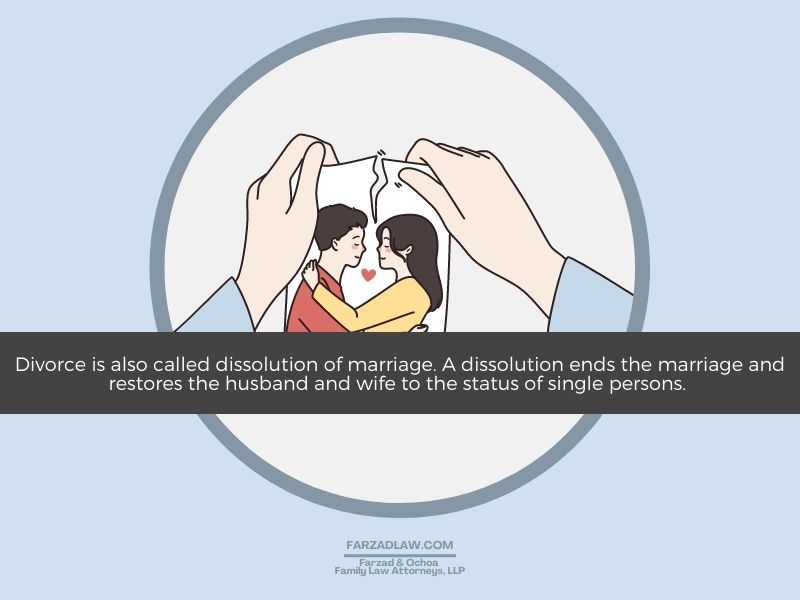
Divorce is also called dissolution of marriage. A dissolution ends the marriage and restores the husband and wife to the status of single persons.
Legal separation does not end the marriage. Instead, a judgment of legal separation keeps the marital status intact.
A legal separation is different from divorce in this respect. Everything else about divorce in California versus a legal separation may be the same.
Legal separation includes obtaining a judgment on the same issues such as child custody, child support, spousal support, dividing assets and debts, and more.
Annulment in California is different from a divorce and legal separation. As we wrote in our guide on California annulments (linked below),
In an annulment in California, the marriage, itself, is in question - its validity and enforceability. An annulment is like an eraser at the end of a pencil. You are looking to undo what has been done.
Here are some links to learn more.
How to divorce in California?
We assume you intend to hire an experienced divorce lawyer. With that assumption, here are the ten steps of how to divorce in California.
- Step one - interview California divorce lawyers.
- Step two - select your California divorce lawyer.
- Step three - set a strategy and budget for your divorce.
- Step four - obtain necessary, temporary court orders.
- Step five - Exchange preliminary financial disclosures.
- Step six - obtain the information you do not have through the "Discovery" process.
- Step seven - settle undisputed issues and attempt to resolve disputed issues.
- Step eight, if necessary - set a trial date for disputed issues.
- Step nine - Exchange final financial disclosures.
- Step ten, if necessary - Trial.
We cover these steps in detail within our guide on how to get a divorce in California. You will find a link for that guide below.
Filing for divorce in California
Filing for a divorce and California is not complicated, although it is easy to screw up.
The essential documents are the following:
- Family Law Summons.
- Petition for Dissolution of Marriage.
- Attachments to the Petition which may include some, all (or potentially none) of the following
- An FL-105 (Declaration under Uniform Child Custody Jurisdiction and Enforcement Act). It is called UCCJEA for short. Parents with minor children must complete this form.
- Legal custody, physical custody, and parenting time forms that may include FL-311, FL-312, FL-341(c), FL-341(d), and FL-341(e).
- A community and separate property declaration (FL-160)
There are also local county forms.
The court charges a filing fee which is as of 2021, $435. A person may apply for a filing fee waiver if they qualify.
Serving divorce papers in California
There are different ways to serve divorce papers in California. We are not going to go through all of them. Instead, we will discuss the two standard methods of service.
Personal service of divorce papers.
Personal service is what it sounds like - someone personally handing the divorce paperwork to the other spouse. One spouse cannot serve the other spouse.
Service must take place by someone other than the spouse. It is a good idea to use a registered process server or a person who works at a reputable company that serves legal papers.
Some companies provide the service of divorce and other legal papers at a reasonable cost.
Service of divorce papers through a notice and acknowledgment of receipt.
A notice and acknowledgment of receipt form is, as of 2021, is FL-117.
The purpose of this document is for the filing spouse to give the other spouse the opportunity to accept the service of the divorce papers without personal delivery.
Offering service this way is a more amicable way of doing it. Personal service may upset the other spouse if you care about that.
A notice and acknowledgment of receipt is a good idea if the filing spouse believes the divorce will be amicable and does not have concerns about the other spouse lying about income, hiding assets, taking the children outside of California, etc.
If there are any such concerns, personal service is better to ensure immediate application of the Standard Family Law Restraining Orders on the back of the California family law summons.
California divorce papers.
Every divorce has some "papers" in common.
We covered the initial divorce papers - summons, petition and attachments, UCCJEA, and local forms.
What are the other divorce papers? The most common are the following:
- Response to the California divorce petition, which is the FL-120. The response to the petition is the document the "respondent" spouse files after the "petitioner" spouse filed and served the summons, petition, etc.
- Each spouse's preliminary financial disclosures. These include the Declaration of Disclosure (FL-140), Declaration Regarding Service of Declaration of Disclosure and Income and Expense Declaration (FL-141), Schedule of Assets and Debts (FL-142), and Income and Expense Declaration (FL-150).
- Family law form interrogatories (FL-145).
- Family Law Judgment (FL-180), Appearance, Stipulation, and Waiver (FL-130), Declaration Regarding Default or Uncontested Judgment (FL-170), and Notice of Entry of Judgment (FL-190).
The above is the bare minimum in most cases.
Spouses should also complete the Final Declaration of Disclosure (similar to the preliminary one) unless they decide to waive it (and yes, there is a form for that too).
Other papers in a California divorce may include the following. The following is a partial list and most common in contested divorce cases.
- Written discovery propounded by one spouse on the other. These divorce papers are usually customized for the case and are not forms. They may include special interrogatories, request to produce documents, request for admissions of fact, notice to the other spouse to appear and testify at a deposition (and produce documents), and more.
- Deposition subpoenas for a person or entity to produce records, testify in a deposition, or both.
- Subpoena to appear and testify (and potentially produce documents) at a hearing or trial.
- Request for Order (FL-300) when one spouse wants one or more temporary orders. The response to the request for Order is an FL-320. These may include child custody, parenting time, child support, spousal support, attorney's fees, property restraint, property control, and more.
- Written briefs that state a spouse's position on the divorce issues.
- Witness and exhibit lists.
- Stipulation and order, when the spouses agree on temporary issues and want to memorialize it into an agreement that becomes a court order.
- Findings and order after hearing (FL-340), when the spouses went to a hearing, and the judge made orders at that hearing.
Each California county has local divorce forms and papers.
California divorce records
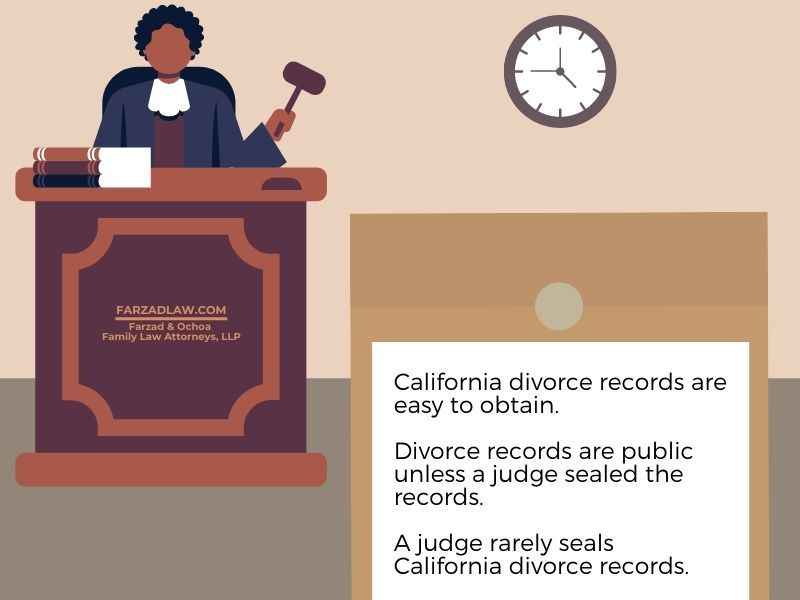
California divorce records are easy to obtain. Divorce records are public unless a judge sealed the records. A judge rarely seals California divorce records.
For this guide, we will focus on Los Angeles, Orange County, and San Diego. Other counties have similar procedures.
Visit each URL below to obtain divorce records in the county. The process is much faster with a case number. If this is your divorce, you should have the case number.
Orange County divorce records.
Advantages or disadvantages of filing for divorce first.
Spouses often wonder if there is an advantage to being the first one to file a divorce.
The short answer is there is no advantage to filing first.
However, procrastinating to file comes with serious disadvantages.
When you file and serve a divorce petition, specific orders automatically go into effect. These are called Standard Family Law Restraining Orders.
We touched on them earlier in this guide.
These Standard Family Law Restraining Orders state the following.
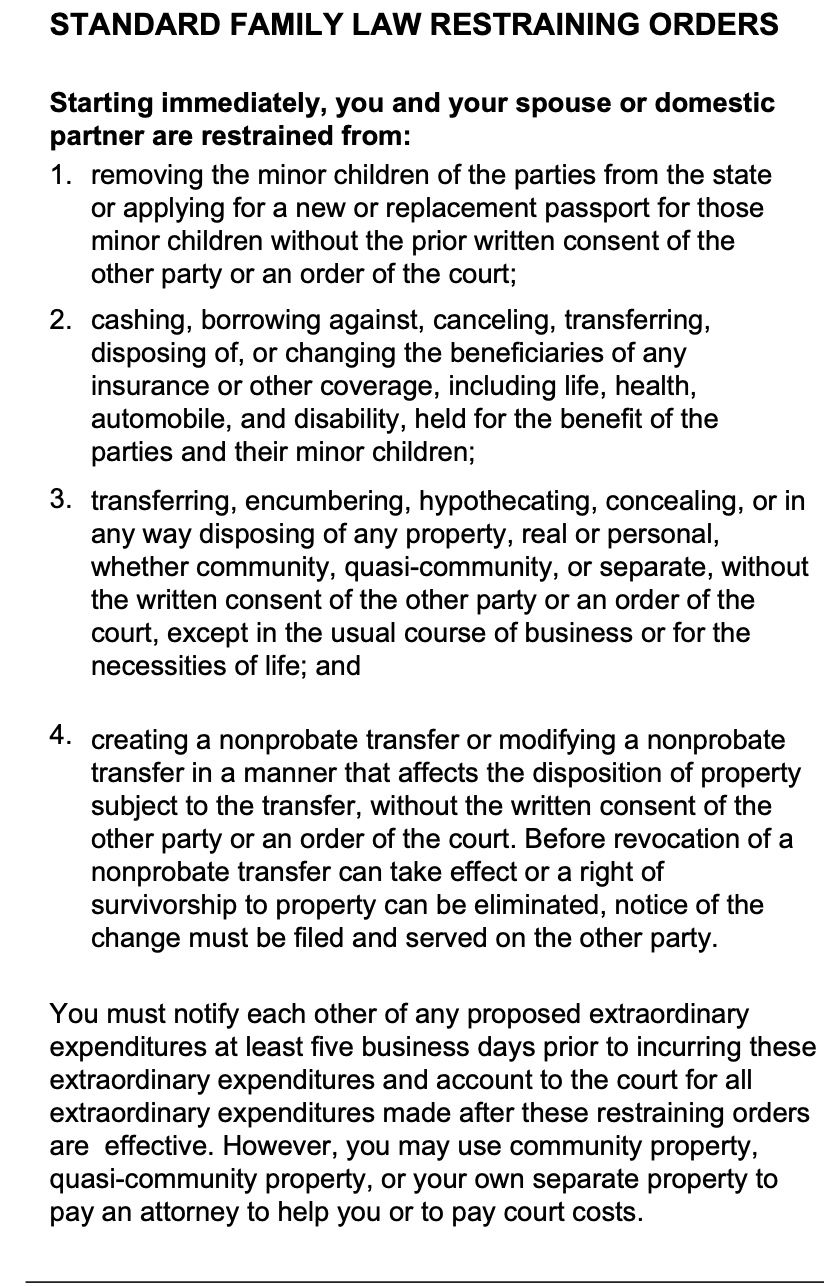
In addition, failing to file may give your spouse more time to engage in misconduct and more challenging to undo the wrongs they committed.
Your spouse may refuse to let you see the children, and every day that goes by without filing is every day you do not have a proper court order.
If your spouse is abusive, seeking a restraining order can protect you from further abuse and remove your abusive spouse from the home. You do not have to file for divorce at the same time.
Your spouse may engage in conduct that hurts the financial estate. When you file for divorce, not only do the Standard Family Law Restraining Orders kick in, but you can seek additional and immediate court orders.
How much does a California divorce cost?
There is no way to estimate what a divorce will cost. That is because the cost of divorce in California is controlled entirely by the spouses. The lawyers do not control divorce costs. The judge and family law system does not dictate it.
The more the spouses agree to resolve issues and do so early (making the divorce more amicable), the less expensive the divorce becomes.
But "less expensive" does not mean cheap. Some divorces require expert witnesses, even when they are amicable.
These divorces may involve forensic accountants who value one or more businesses, determine available income for support, conduct an analysis of the marital status of living, review documents to trade a separate property or community property claim, and more.
So why is the divorce cost unpredictable?
- Because nobody controls what positions spouses take other than the spouses.
- And if the spouses had a bitter or high conflict breakup, chances are good they will have a contested divorce ahead of them.
- Divorcing an alcoholic or an addict causes a divorce to become more unpredictable and adds fees and costs because children may not be safe with the substance abusing parent. That potential danger may require addiction experts and more contested court hearings.
- If you add one of or both spouses have a high conflict personality, then add another layer of complexity. Divorcing a narcissist or worse, a sociopath, can make divorce cases an all out war.
If you are going through a divorce, can you predict every step of the way what your spouse will state, do and what positions your spouse will take on different issues? Can you guarantee it? The answer is obviously no. And that no is why nobody can predict the cost.
Now the good news. Just because nobody can predict divorce cost or provide an estimate of it does not mean you are writing a blank check.
We wrote a terrific article on the subject of divorce cost. Here is a link to it: How Much Does a Divorce Cost.
That article will show you what factors control cost - make it go up or down. It will educate you on what you can do to keep fees and costs reasonable.
How long does a divorce in California take?
The length of a divorce is similar to the cost. The spouses control it.
How long a divorce takes in California depends largely on whether the spouses resolve the issues within a reasonable time.
Consider the following hypothetical.
The spouses have been married for 15 years and have two children, ages 12 and 13. They own a home with modest equity. Both of them work, but one spouse significantly outearns the others to us. They are both W2 employees. Both of them have retirements through their employment. They have various bank accounts, cars, jewelry, furniture and furnishings, and appliances. The spouses have a modest amount of debt.
Should this divorce take years? The answer is no. Can it take years? The answer is yes.
You may ask yourself how something like that is possible. It sounds like a modest estate and no complex issues. Here is how.
- The spouses dispute custody. One of them believes the other one is not a fit parent. Now you have contested issues over temporary orders while the divorce is pending. These disputes may cause the involvement of private child custody evaluators, a lawyer for the children, and numerous court hearings as a result.
- Since child support affects parenting time and spousal support is directly connected to child support, these issues also do not resolve. They go along for the ride. Meanwhile, the spouses have disputes over temporary support orders. One spouse claims the other one is using the children as leverage. The other spouse claims they do not receive enough support for the children and themselves.
In this hypothetical, I only addressed three issues. I have not even gotten to the house and other assets, nor the division of debt.
Suppose the spouses could amicably resolve the custody issues. In that case, they can determine child support, and child support helps resolve spousal support. A contested divorce that may have gone 1.5 years or more may resolve in under six months.
Don't some divorces have to go longer even if they are amicable?
Yes, some divorces will take one or more years, even if there are no significant disputes.
These divorces usually involve complex financial issues. Suppose multiple businesses need to be valued, and reasonable disputes exist between the spouses regarding income available for support. In that case, they will need forensic accountants and other financial experts. And if you have an extraordinarily high earner, then child support gets more complex.
This work is not quick or cheap. The more complex the business, asset, and income structure, the more time it takes to figure out the likely result consistent with the law.
What are divorce laws in California, and where do you find them?
You find California divorce laws in code sections, the California rules of court, and case law.
Most of California's divorce laws are in the California Family Code. The Family Code sets forth substantive law on child custody, parenting time, child support, spousal support, asset, and debt division, reimbursements, domestic violence, and more.
Other California code sections include the California Code of Civil Procedure. As the name expresses, procedural rules that control all civil cases (and family law cases are civil cases) are often in this Code of Civil Procedure.
The California Rules of Court are different from code sections. They set forth rules by which courts must operate and handle cases, including family law cases.
They also set forth obligations of parties and lawyers. There is a lot of overlap between the rules of court and code sections.
You can even say there is unnecessary repetition. However, there are rules within the rules of court that you do not find in any other place, and it is essential to know them.
California cases in our Appellate Courts and Supreme Court also include California's divorce laws
Much of the laws of divorce in California are the result of California Appellate and Supreme Court decisions.
These "higher" courts do not make law - or at least they are not supposed to - but rather interpret the existing laws. Sometimes that interpretation clarifies how a judge should interpret a code section.
Higher court rulings help lawyers understand how they should present their position, and judges understand how to make rulings.
What is the divorce process in California after filing and service?
Divorce laws in California are different from a divorce process. The process focuses on the order of events.
We took you through the divorce process earlier in this guide when we addressed how to divorce in California. The divorce process starts with a divorce petition and ends in a divorce judgment.
Their petition is the beginning of the process. The judgment is supposed to be the end of the process. However, it is common for there to be post-judgment modification proceedings on issues such as custody and support.
Rather than complicate this guide with a lengthy recitation of the California divorce process, we instead refer you to a comprehensive guide we wrote on this exact topic. Not coincidentally, it is called the California divorce process.
What is the California divorce "10-year rule," and why it matters for alimony?
Family Code 4336 states the following.
"(a) Except on written agreement of the parties to the contrary or a court order terminating spousal support, the court retains jurisdiction indefinitely in a proceeding for dissolution of marriage or for legal separation of the parties where the marriage is of long duration.
(b) For the purpose of retaining jurisdiction, there is a presumption affecting the burden of producing evidence that a marriage of 10 years or more, from the date of marriage to the date of separation, is a marriage of long duration. However, the court may consider periods of separation during the marriage in determining whether the marriage is in fact of long duration. Nothing in this subdivision precludes a court from determining that a marriage of less than 10 years is a marriage of long duration.
(c) Nothing in this section limits the court's discretion to terminate spousal support in later proceedings on a showing of changed circumstances.
(d) This section applies to the following:
(1) A proceeding filed on or after January 1, 1988.
(2) A proceeding pending on January 1, 1988, in which the court has not entered a permanent spousal support order or in which the court order is subject to modification."
The rule you just read is what people often call the "10-year rule."
There are two misconceptions about the 10-year rule.
- Misconception number 1 is a ten-year or longer duration from marriage to separation means spousal support must be for life.
- Misconception number 2 is just because a marriage is under ten years means spousal support cannot last more than half the duration of the marriage.
Let's dispel both myths.
A court may order spousal support in a "long-term marriage" (10 or more years) until the death of either spouse, remarriage of the supported spouse, or further order of the court.
However, a court may also limit spousal support by the following:
- Terminate it in the present at a specific date in the future.
- Terminate it in the future at the request of a spouse.
- Step it down to zero (that is different from termination).
- Attach conditions to the payment of ongoing spousal support.
What the court chooses depends on the facts. Those facts may include:
- How far past the ten years mark the marriage is (big difference between a ten year and 6-month marriage and a 20-year marriage, right?),
- A spouse's need for support,
- Ability to pay support,
- The marital standard of living,
- The employability of a spouse,
- Domestic abuse during the marriage,
- Disability or health of a spouse, and
- Retirement of a spouse at retirement age and other factors.
Not coincidentally, these same factors also affect whether a court may treat a marriage under ten years as a long-term marriage.
The nuances are one reason spousal support is sometimes the most complex issue in a divorce, especially when dealing with the above issues.
Here are additional articles you will enjoy on these spousal support (also called "alimony" topics).
- How long do you have to be married to get alimony?
- How long do you have to pay alimony after a divorce?
- Alimony in California after 10 years of marriage
- How can I end spousal support?
Should a husband or wife move out before or during the divorce?
Several factors affect the choice to move out. None of them are emotional or illogical. Moving out for the wrong reasons may cause more harm than good.
Here are the common reasons one spouse chooses to move out.
Physical safety of the spouse or children.
If a spouse lives with an abuser, there are usually two options.
First, determine if there is a legal basis for a restraining order so you can lawfully kick out the abusive spouse.
Second, get to a safe place where you can protect yourself and your children. A domestic violence shelter is a good example of a safe place.
Staying in an abusive relationship is unfortunately common. We see it more than we wish we did. Most victims of domestic violence do not realize the options available to them. That is why we take our time to explain it.
The danger of false domestic violence allegations.
Some spouses are nefarious. They are willing and capable of making false domestic violence allegations against the other spouse. We see this situation when the nefarious spouse has a history of false allegations and is an angry and toxic personality.
It may make sense for the other spouse to move out before filing for divorce.
Divorce can raise the ire of spouses who already have anger management issues and are awful enough to make false abuse allegations.
Having a plan to get out of the house and immediately filing for temporary child custody orders (assuming the spouses have kids) is often a good idea.
Getting away from a financially abusive spouse so the abused spouse can receive support.
Financially abusive spouses often control their spouse to such an extreme that the abused spouse is constantly on the edge of uncertainty.
The uncertainty includes whether they can afford food on the table for themselves and their children and provide for necessities.
Financially abusive spouses are usually mentally sick control freaks. They regulate every dollar in and out of the family's finances.
Ironically, they are also often hypocrites. They spend money on themselves but refuse to provide access to that same money (often community property money) to their spouse.
This refusal to provide access is a serious breach of that spouse's fiduciary duties to the other spouse. It may necessitate the abused spouse to file a request to receive support (often child and spousal support), so they can move out.
It is sometimes unwise to move out first and then file the support request because the gap of time from the move out to the hearing date may be financially challenging for the abused spouse.
However, if there is domestic violence, staying in the house is not a safe option.
What if there is no domestic violence?
Is a spouse pestering the other spouse to move out a good reason for the other spouse to move out? Generally, no. Moving out should be a voluntary choice, not a pressure-filled one.
What is a California divorce mediator, and what does a mediator do?
We only write about divorce mediators who are also experienced family law attorneys. We strongly believe spouses should not hire a non-family law attorney to be a mediator. Such persons are too often unqualified to provide the service. Some are completely incompetent.
A California divorce mediator is a neutral attorney who helps spouses reach a resolution of some or all of the issues in the divorce.
The mediator does not represent either spouse. They are not either spouse's advocates.
That is precisely why competent mediators strongly recommend each spouse hire their independent attorney during the mediation process - so they have an advocate who can tell them of their options they may otherwise not know.
What does a California divorce lawyer do for you?
A California divorce lawyer represents a spouse. A divorce lawyer cannot represent both spouses. That would be a conflict of interest.
California divorce lawyers typically handle a divorce on behalf of their client from start to finish. The exception is when the lawyer withdraws their representation before conclusion or their client terminates their services.
Divorce lawyers prepare all divorce papers on their client's behalf, file and serve the paperwork and make court appearances. Some court appearances only involve lawyers. Some require the spouses to attend.
Additional topics about divorce in California
Divorce is a complex area of law, and divorce in California has significantly changed in the last half a century. For that reason, there is still confusion about certain aspects of California divorce where the public retains old misconceptions.
Some of these may arise from what used to be the law but is no longer. Others may be an urban legend that some people still believe and spread.
We cover these additional topics below, starting with the grounds for divorce in California.
Grounds for divorce in California
The grounds for a divorce is an area that changed significantly. We discuss one aspect of it in the next heading under no-fault divorce.
Focusing on the current law, the following are grounds for a divorce.

You will find these grounds listed on page two of every divorce petition and response to the petition.
What does a no-fault divorce mean?
"No-fault" is a source of confusion among some people.
No-fault divorce means a spouse does not have to show "fault" by the other spouse to start a divorce. Until 1969, California was a "fault" State where one spouse could not divorce the other spouse unless they could show some "fault" by the other spouse.
That all changed when California became a no-fault State. When California did, it was enough to state there were irreconcilable differences that led to the permanent breakdown in the marital relationship, and no counseling, passage of time, or any other event will change that fact. There was no longer a requirement to show "fault."
That does not mean "fault" is irrelevant in a divorce. On the contrary, spousal abuse or financial misconduct is relevant to issues in a divorce. They may affect custody, support, asset division and potentially lead to a domestic violence restraining order. Even infidelity matters to a limited financial extent. We discuss that more immediately below.
What about infidelity that results in divorce, and does infidelity matter?
Infidelity matters to the extent the spouse who committed it used community property money on the extramarital affair or affairs. It is one thing to "cheat" on a spouse. It is quite another to spend half of their money on that affair.
Those spouses who commit infidelity and spend significant sums of money on gifts, housing, payment of expenses, etc., of the person with whom they are having an affair, are often partially spending their spouse's money without their spouse's knowledge and consent. Since spouses are fiduciaries to each other (and have the highest duty of loyalty and fair dealing on financial issues), that conduct may give rise to a breach of fiduciary duty action and, at a minimum, reimbursement of the money spent.
California divorce waiting period
Most spouses with a divorce ahead know there is a "six months" waiting period of some kind. Many do not understand what the six months mean (and what it does not). Unfortunately, this lack of knowledge causes some spouses to make false assumptions, including the belief that they are divorced when they are not.
Fortunately, you do not have to make those mistakes. You do not have to guess what California's divorce period means.
We wrote an article on the waiting period in California divorces. The article, linked below, explains what the waiting period is and how it works. Check it out to learn more.
Divorce by default and how it works in California
Some divorces in California result in a "default" against the "respondent." The respondent is the spouse served with the divorce petition filed by the "petitioner." The petition starts the divorce process.
Here is how part of California's divorce summons reads on responding to the petition:
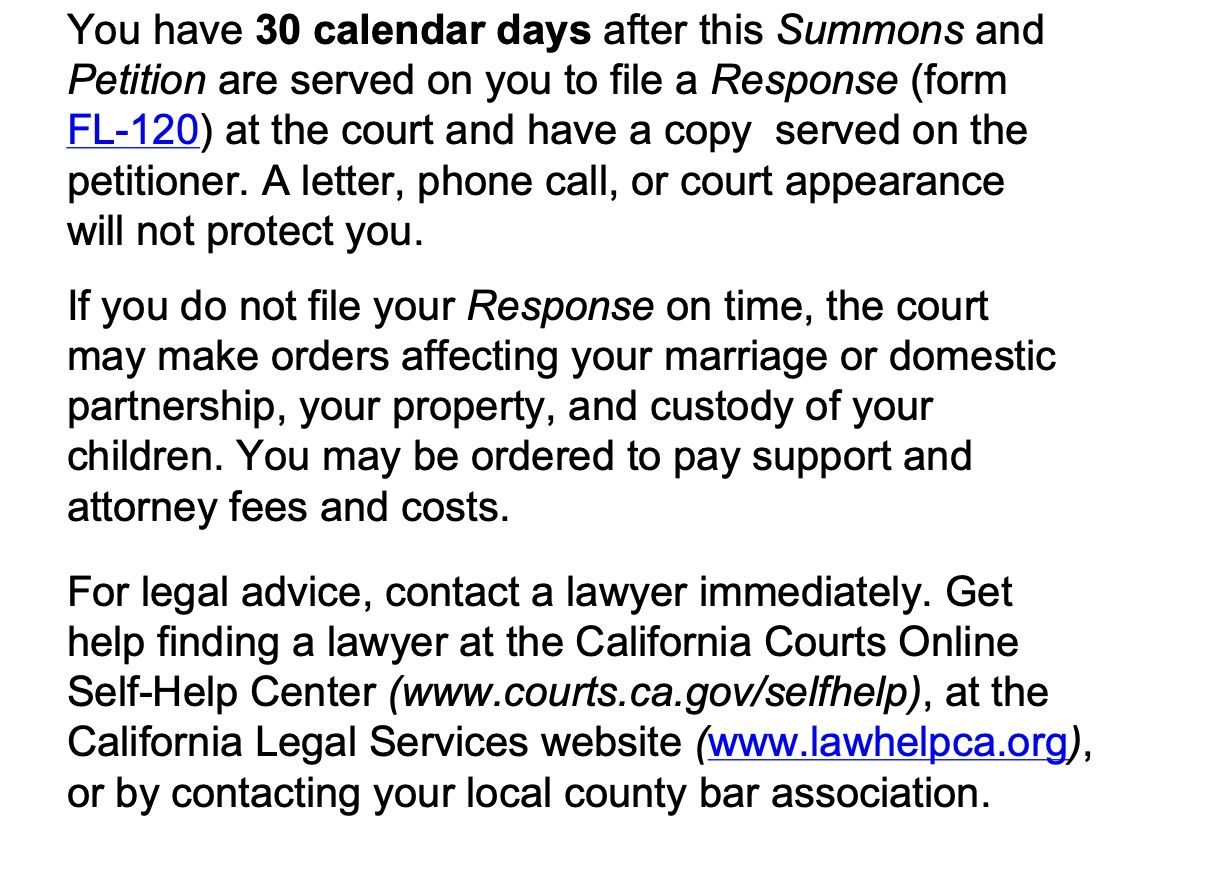
What happens if the respondent does not file and serve a response? The petitioner then has the option of taking the respondent's default. The petitioner does this by filing with the court the FL-165. Here is part of that form (the important part):
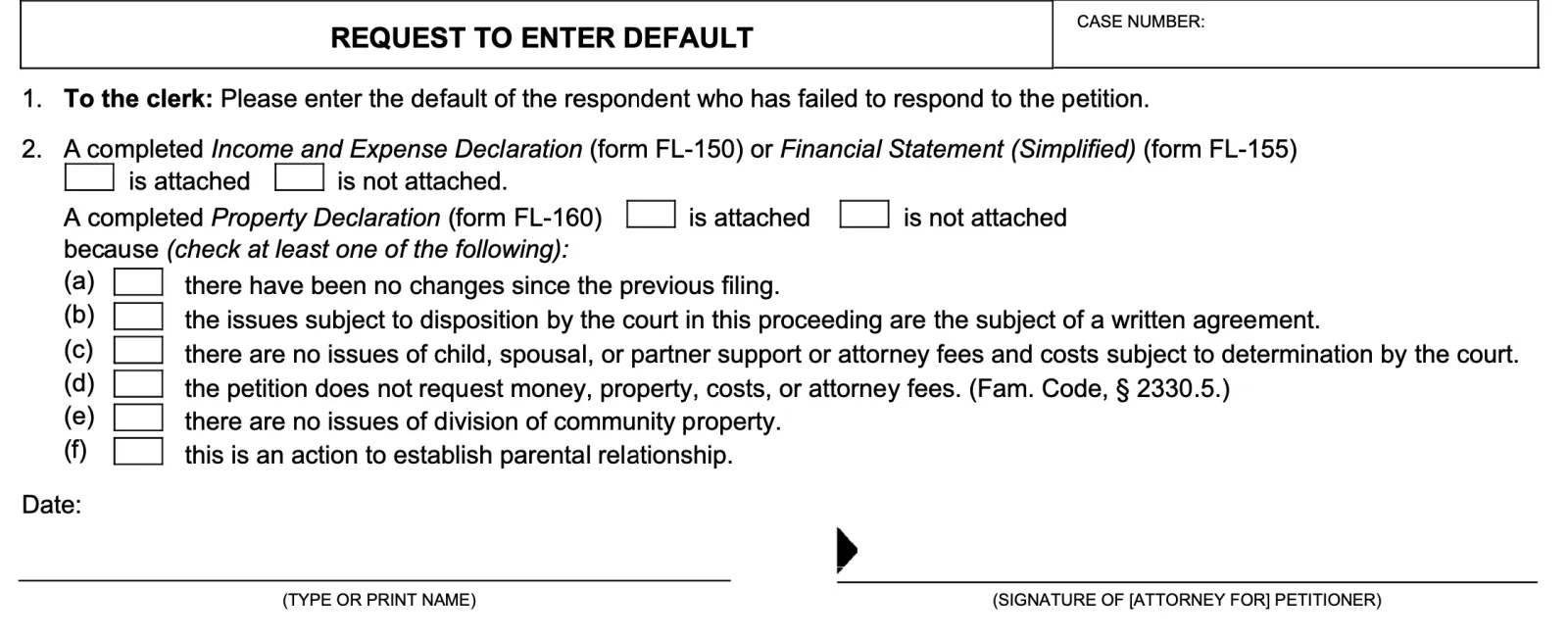
Sound easy so far? It is not. Spouses, especially those who are self-represented or go through inexperienced attorneys or non-attorneys (document preparers), often screw up the petition process and doom the default process.
That is because "due process" requires a petitioner who wants to take a respondent's default to state their specific requested relief. And that means you need a lot more than checking off some boxes. The issue is complex and has too much information to cover here - honestly, it is a guide in itself).
If that sounds confusing, it is. That is why you need an experienced attorney. Trying to navigate a default in a California divorce without professional representation is foolish and dangerous.
Contested versus uncontested divorces in California.
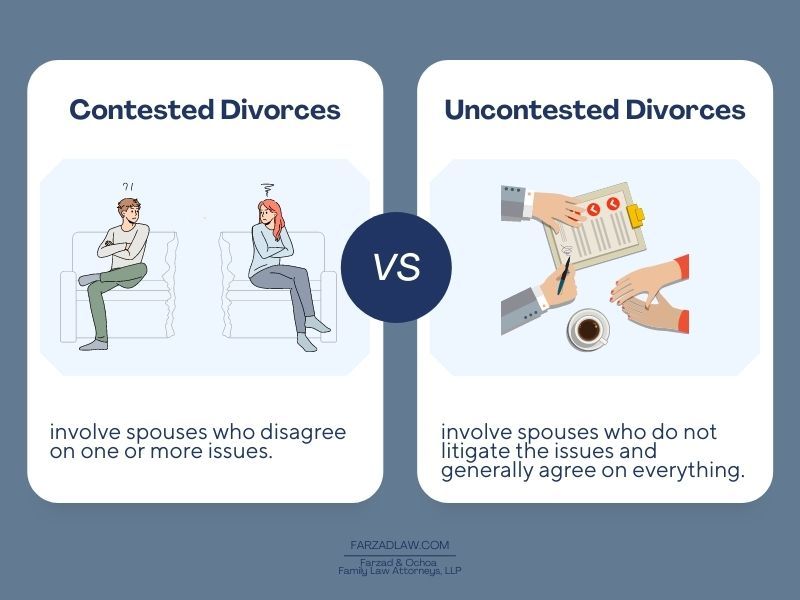
A contested divorce in California results from spouses who disagree on one or more issues.
For example, spouses in a divorce may disagree on child custody, and the spouses litigate those issues.
That means child custody was a contested issue during a divorce. The more issues the spouses contest, the longer and more expensive the divorce becomes.
Uncontested divorce often means the spouses do not litigate the issues and agree on everything. However, it is also possible there are contested and uncontested issues.
Using the same example, let's say the spouses litigate custody but agree on property division, spousal support, and child support (as soon as they figure out what parenting time will be). In that situation, everything in the divorce is uncontested except the child custody issues.
It does not matter how you title a divorce as contested versus uncontested. Instead, spouses should look at a divorce as a set of issues they can either resolve through agreement or the litigation process where the judge makes the decision.
California divorce with a domestic violence restraining order
Domestic violence restraining orders make any divorce, small or large, more complex. That is because domestic violence restraining orders affect nearly every issue.
Restraining orders are directly related to child custody, parenting time, and therefore child support. They also have a direct effect on spousal support.
For example, suppose a domestic violence perpetrator with a history of documented domestic violence seeks spousal support. In that case, that perpetrator may not get the spousal support or may get less than the amount they would have received absent domestic violence.
Domestic violence can even affect the division of assets and responsibility for attorney's fees.
Since this is a complex topic, we wrote specific articles on it.
Here are links to those articles we encourage you to read.
Domestic Violence's effect on spousal support, fees, and assets
Domestic Violence's impact on child custody
If you want to learn more about domestic violence, we wrote one of the best guides on the internet: Domestic Violence Definition, Statistics, Awareness, Law & Advocacy
Bifurcating a divorce in California
Bifurcating a divorce in California is another area spouses often do not understand.
Let's face it - we do not use a word like "bifurcation" each day. What does it even mean? Think of bifurcation as splitting off one or more issues from the rest of the case. In a family law case, it usually means one of two things.
- Sometimes, one spouse seeks an early termination of the marriage. That spouse wants to be divorced from the other spouse even though there are unresolved issues. That early termination has many drawbacks, and spouses should be careful proceeding with such a request. Sometimes, this request is a good idea, and other times it is reckless and purely for emotional reasons. It is beyond the scope of this guide to discuss it in detail. Make sure you understand the severe consequences that can come from such a choice. Reading Family Code 2337 is a good start.
- Splitting off specific issues from the rest of the case and litigating those issues to an earlier conclusion through a trial.
If a spouse wants an issue (or marital status) bifurcated, they usually have to file a written motion and request it. It is not unheard of for a court to order it on an oral request, but that is rare. Is an oral request proper? That is a question for another article.
Just because a spouse requests a bifurcation does not mean the spouse will get it. And even if neither spouse asks for it, the court may order a bifurcation of issues on its own motion - although a court cannot order an early termination of marriage that way.
Your Strategy Session
About your strategy session
Southern California Offices
Locations
Our Services and Fees
Frequently asked questions
Strategy sessions are designed for those who are serious about their family law case, want to make informed and intelligent choices, and seek result-focused representation.